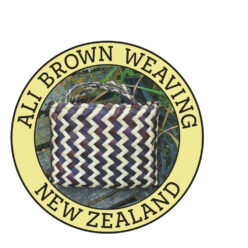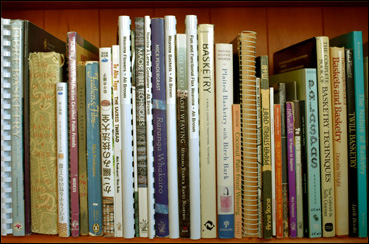
Links to sections of this page:
- Flax weaving techniques
- My books
- Flaxwork exhibitions and collections
- Flax in Māori culture
- Contemporary weaving magazines
- Growing and harvesting flax
All of the books reviewed below can be borrowed from New Zealand public libraries. Books that are still in print can be bought online from Fishpond (a New Zealand bookseller), Amazon (a US bookseller) or — in some cases — Collectiblebooks (a New Zealand bookseller that doesn’t take credit cards online but does take internet banking or direct credit payments). Generally, Fishpond offers a lower shipping-inclusive price for NZ buyers than Amazon. Second-hand copies of out-of-print books can often be found at Amazon or Abebooks.
Books that include flax weaving techniques
Fun with Flax: 50 Projects for Beginners
Mick Pendergrast. Reed Publishing (NZ) Ltd, 1987.
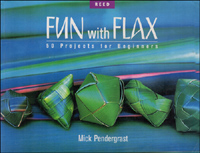
This is an excellent book for beginners. As the title indicates, it includes illustrations and instructions for 50 projects, most of which are quick and easy to complete and are particularly suitable for children, e.g., a fish and other animal shapes, stars, puzzles, boats and darts. Unfortunately Fun with Flax doesn’t include instructions for making a simple woven basket (kete), a project many beginners are keen to tackle (see next book review) — though it does include instructions for a knotted basket and a basket made with sewn plaits as well as various plaiting techniques that will find a use in other weaving projects.
Māori Weaving
Erenora Puketapu-Hetet. Addison Wesley Longman NZ Ltd, 1999.
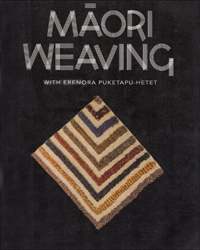
This is the only book I’m aware of that contains step-by-step instructions for a simple woven kete (basket) — one in which the flax strips are folded over to make the bottom of the kete, thereby limiting the height to about 20 cm. (Most traditional kete designs involve weaving or plaiting two sets of strips together at the bottom, a relatively complex technique, but one that allows the ketes to be up to twice the size, and also allows them to be woven in complex coloured patterns. The five books reviewed directly below Māori Weaving provide instructions for ketes joined at the bottom although last three are very basic.) In addition to instructions for weaving a simple kete, Māori Weaving includes illustrations of numerous flaxworks and information on traditional Māori culture applicable to weaving, and on various native plants used for weaving and dyes.
Te Mahi Kete: Māori Flaxcraft for Beginners
Mick Pendergrast. Reed Publishing (NZ) Ltd, 1975.
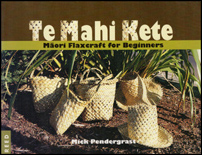
Te Mahi Kete contains instructions on how to weave a traditional Māori kete (basket) starting with a base plait, along with variations on making the base with two or four corners. The book is illustrated with detailed line drawings and black-and-white photos, and also includes instructions on how to weave a flax sunhat starting with a base plait. An appendix at the back of the book has some useful tips on good weaving practice, and the Further Reading section includes articles published in New Zealand journals.
Raranga Whakairo: Māori Plaiting Patterns
Mick Pendergrast. Reed Publishing (NZ) Ltd, 1984.
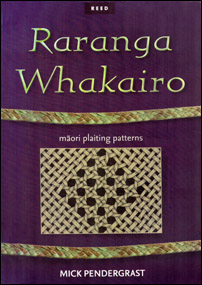
Patterned weaving is an attractive feature of traditional flax weaving and this book illustrates, with clear black and white line drawings, how to set the patterns for a large number of coloured and self-patterned weaves. Each pattern’s origin and original weaver is documented along with some indication of how the pattern is executed. Some of the patterns are straightforward to interpret and set up but some of the more complex diagrams will require careful thinking and preparation to complete.
Māori Fibre Techniques
A Resource Book for Māori Fibre Arts
Ka Tahi: Hei Tama tu Tama
Mick Pendergrast. Reed Publishing (NZ) Ltd, 2005.
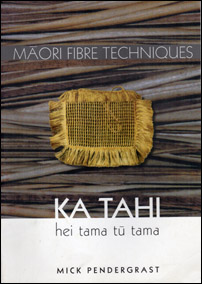
Describing a variety of different fibre techniques used by Māori and other Pacific cultures, the author connects weaving of the Pacific region to the universal world of basket-making. He documents many of the traditional Māori techniques used in making clothes, baskets, nets and wall panels, illustrating these with close-up photos and clearly-drawn diagrams. Techniques from other cultures include three-directional plaiting (weaving) and right-angled plaiting, which are both useful for creating different shapes.
Kete Whakairo: Plaiting Flax for Beginners
Margaret Rose Ngawaka. Trafford Publishing, 2013.
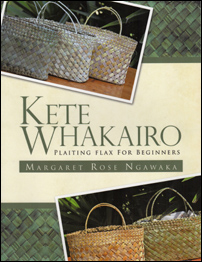
Illustrated with colour photos, Kete Whakairo shows how to weave a traditional Māori kete (basket) with a different technique from that shown in Te Mahi Kete. The technique in Kete Whakairo involves joining a flat piece of weaving into a cylinder, weaving a plait around the top of the cylinder, joining the bottom of the cylinder together, and then turning the cylinder inside out to make the basket. Like Te Mahi Kete, Kete Whakairo illustrates one of the basic techniques for weaving a large kete. The technique in either book provides a basic kete structure that can be used for the more advanced coloured or self-patterned designs, such as those shown in Raranga Whakairo.
Weaving a Kakahu
Diggeress Te Kanawa. Puwaha ki te Ao Trust, 2006.
Original edition Bridget Williams Books, 1992.
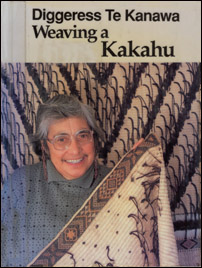
Diggeress Te Kanawa, one of the most well-known weavers of her time, describes in complete detail how to construct a cloak in your own design using dyed flax, feathers and tassels. The book includes ideas for designs, gathering and stripping the flax, separating out and twining the fibre, gathering and preparing natural dyes and then dyeing the fibre, preparing feathers, and a detailed description of the weaving method (a form of twining), adding shaping to the weaving and taniko weaving for the border. The materials list of “700 warp threads, 2 long cords dyed black, at least 5 hanks of weft thread (50 threads to one hank), feathers from 4 birds, and 200 tassels” — all of which need to be prepared by hand before the weaving has even started — illustrates the enormous amount of work that goes into the making of a cloak! This book is an excellent guide if you’re going to do just that.
The Art of Piupiu Making
Ngapare Hopa. AH & AW Reed Ltd, 1971.
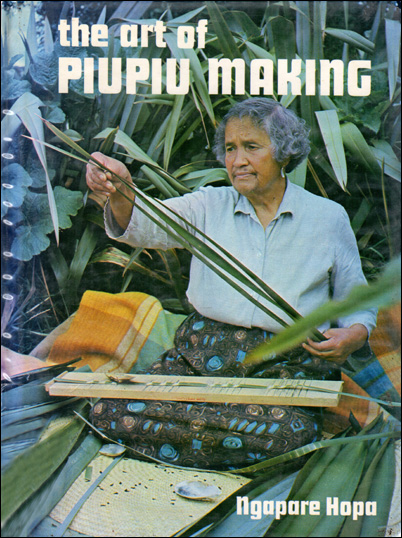
This book covers, in very comprehensive detail, the traditional way to make a skirt or piupiu. It describes the preparation of the flax, assembly of the prepared pieces, how to make a pattern board and how to transfer the pattern to the flax strips, scraping the flax and assemby of them into a piupiu, dyeing of the assembled strips and the weaving of a plaited or geometrically-patterned waistband. The step-by-step instructions are easy to follow and are illustrated with line drawings and black-and-white photos. An informative section on preparing and using traditional natural dyes and dyeing methods is a valuable resource.
How to make a Piupiu
Leilani Rickard. Penguin Books Ltd, 2008.
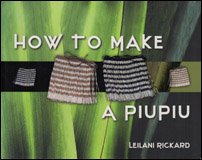
Leilani Rickard explains, with full colour photos, the methods used in making a piupiu. All the techniques used to make a piupiu are illustrated, including cutting and stripping the flax into strips, marking and scraping the patterns onto the strips, boiling, the twisting of flax fibre into cords to make the waistband, and traditional mud-dyeing of the completed piupiu. If you are using the information in this book to make a piupiu, do study the flow chart on pages 90-91, as it combines all the methods and techniques in a step-by-step plan.
Ceremonial Costume: The Arts of the Māori
New Zealand Department of Education, 1978.
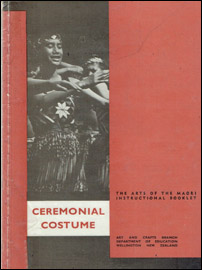
Although this is a small booklet, it is an excellent resource for anyone wanting to make their own basic skirt, bodice, headband or body band to wear at ceremonial occasions. The instructions for making a skirt show how to scrape traditional geometrical designs onto flax strips in preparation for dyeing them, and how to plait the strips into a waistband. Two different methods are described for making geometrical designs for a fabric bodice, head band and body band.
Kete Making: The Arts of the Māori
New Zealand Department of Education, 1975.
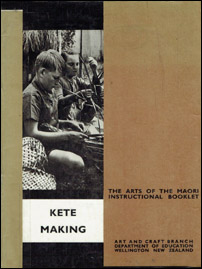
Written for children, this booklet contains basic instructions for weaving a kete starting with a plait at the base, along with clear line drawings and black and white photos. It also includes information on weaving four corners, plaiting handles and finishing the top edge by incorporating a separate plait. There are brief instructions on weaving a patterned kete and diagrams of seven different patterns to weave with.
Tukutuku and Kowhaiwhai: The Arts of the Māori
New Zealand Department of Education, 1976.
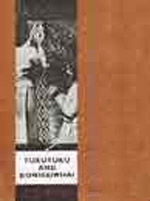
Written for children, this booklet describes the steps to making decorative wall panels, or tukutuku panels, which decorate marae and other public places, and includes traditional patterns as well as patterns designed by children. Although the designing of kowhaiwhai patterns can be a very complicated process, the second part of this book describes a simple process of designing these traditional patterns known, which could be useful in many design situations.
Weaving: The Arts of the Māori
New Zealand Department of Education, 1985.
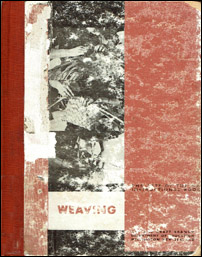
Written for children, this booklet contains instructions for weaving a simple mat, headband, food basket or rourou or kono, and a simple oval basket and so it is a good resource for beginning weavers. It also has brief instructions on weaving a four-cornered basket starting with a plait and so it is also useful for those with some weaving experience. Clear line diagrams and black and white photos illustrate the weaving techniques.
Te Whatu Taniko
Hirini Moko Mead. Reed Publishing (NZ) Ltd, 1999.
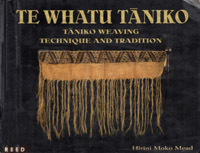
First published in 1968, when the author went under the name of Sydney Mead, this book contains an interesting history of cloak and skirt making, and the changes in fashion in these garments through the centuries. The taniko weaving technique is described in detail, including the preparation of the fibre. Also included are numerous graphed taniko patterns, and an analysis of the historical development of taniko designs.
Te Kono Naku Raranga Harakeke
Jan van de Klundert. Nga Puna Waihanga, 1996.
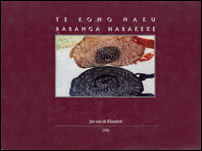
Jan’s innovative work illustrates the flexibility and versatility of flax weaving as a sculptural medium. His instructions for a food basket and a kete are non-traditional and he includes ideas on different ways a plait can be used to start weaving, how to add or decrease the number of woven strips and how to weave with a vertical or horizontal twill. There are also instructions for a round basket which starts with two plaits, a hat and masks. Photos of Jan’s contemporary designs will provide inspiration for anyone interested in exploring new ways of working with flax.
Know Your Māori Weaving: Plaiting – Weaving – Tukutuku – Whakatauki
Murdoch Riley. Viking Svenseas NZ Ltd, 2005.
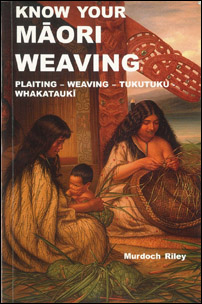
This Pocket Guide is full of good information on the diversity of weaving in New Zealand, and briefly describes the methods used to make baskets, skirts, poi and decorative panels. It also includes information on which native plants can be used to obtain dyes. The delightful cover illustration and two illustrations in the book depict paintings by Gottfried Lindauer, a New Zealand artist whose work is known for its authenticity in recording the customs and the way of life of the Māori people of his era (1839–1926).
Māori Weaving
New Zealand Māori Arts and Crafts Institute and Huia Publishers, 2015.
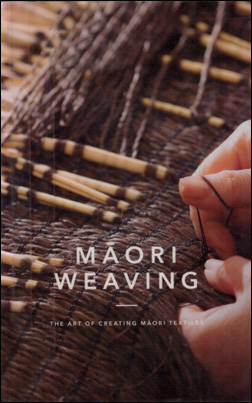
The story of flax weaving is told in this booklet. Starting at the Māori story of creation and the birth of Hine-te-iwaiwa, the principal goddess of Te Whare Pora, the house of weaving, the booklet carries on through the discovery of harakeke by the first Māori migrants to Aotearoa, the weaving process, woven treasures and contemporary innovations and weaving of the future. Two master weavers, Emily Rangitiaria Schuster and Erenora Puketapu-Hetet are profiled, giving a glimpse of the “many Māori weavers who have revived the traditional techniques into a technologically modern and internationally recognised art form.” The book is full of clear and attractive images of flaxworks, finishing with images of contemporary garments.
Making your first small korowai
Robin Hill, Self-published, 2013.
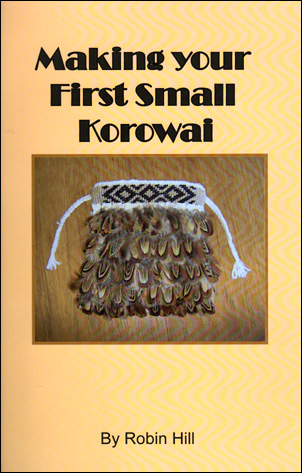
This booklet is designed as a first step to learning the techniques used to weaving a korowai, or cloak. Steps are given to weave a small sample-sized piece for beginners to start with before weaving a full garment. Clear illustrations show the steps which are made with bought cotton, which is easier for beginners to start with, instead of the fine extracted flax fibre or muka that traditional korowai are constructed with.
More tips and techniques for korawai weaving
Robin Hill. Self-published, 2013.
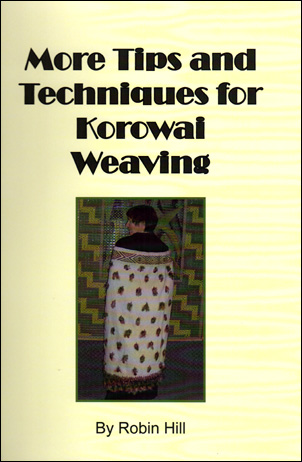
This booklet is a follow on from ‘Making Your First Small Korowai’. It covers more designs that can be used in the construction of the cloak, different aspects of korowai design and tips for coping with problems. Clear illustrations show the steps for each design and different techniques. The samples are made with bought cotton, which is easier for beginners to start with, instead of the fine extracted flax fibre or muka that traditional korowai are constructed with. A useful guide for those starting out in traditional cloak-making.
Mawhitiwhiti patterns and woven bags
Robin Hill. Self-published, 2013.
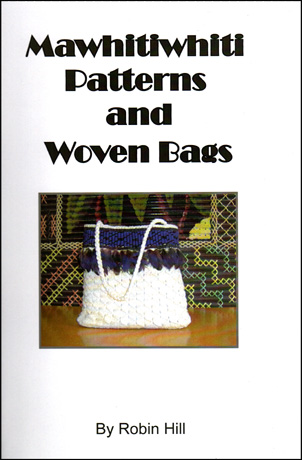
This booklet shows how patterns are made in Māori weaving by changing the direction of the warp thread from the vertical. The booklet contains instructions on how to weave many of these mawhitiwhiti patterns, and how to create different styles of woven bags incorporating the use of this design technique. It is a follow-on booklet from the author’s first two booklets and requires the user to have some weaving knowledge.
Baskets in Polynesia
Wendy Arbeit. University of Hawaii Press, 1990.
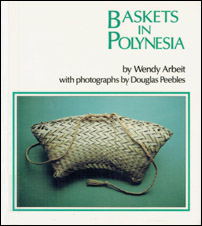
This book documents the great diversity in the weaving styles of baskets throughout the Pacific Islands of Fiji, Tonga, Samoa, the Cook Islands and French Polynesia, and illustrates these differences with many photos. Some basic weaving techniques used in Polynesian-style weaving, are detailed at the end of the book. These are interesting to study and are worth trying out and understanding. The image on the front over portrays a distinct style of palm basket, and a very attractive one, in my view.
Fibre Basketry: Homegrown and Handmade
Helen Richardson, editor. Kangaroo Press, 1989.
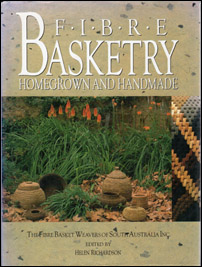
This book contains a great deal of useful information on the use of flax in weaving even though the baskets described are made with coiled and stitched methods rather than the woven method that is generally used for flax weaving in New Zealand. A comprehensive table lists how various different natural materials can be used in basket making and there are good illustrations of baskets that have been made using the different techniques.
My books
Weaving Flowers from New Zealand Flax
Ali Brown. Self-published, 2009. Fourth edition, 2016
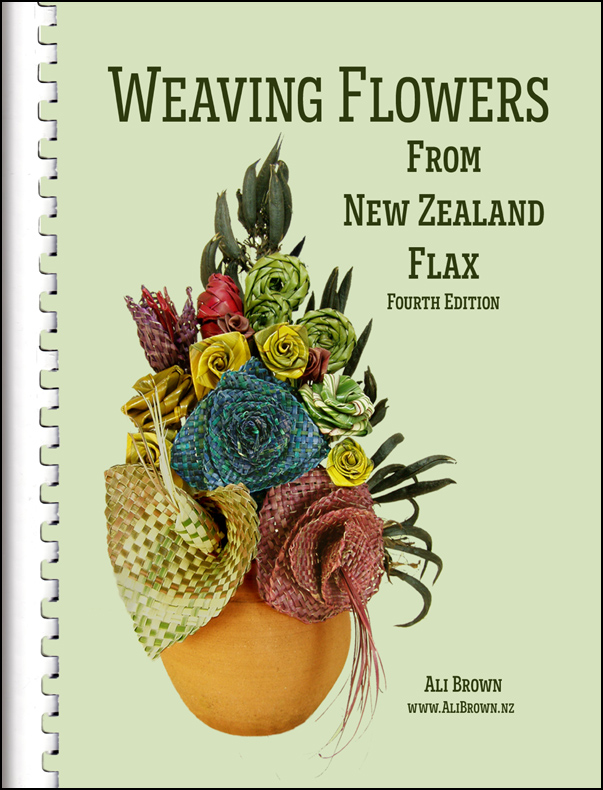
Weaving Flowers from New Zealand Flax contains detailed instructions for weaving twenty flower and foliage designs, including different variations of several of the designs, as well as decorative effects and ideas for weddings and events. The book includes examples of flower arrangements for the designs, and additional flax foliage ideas for flower arrangements. Most of the flower designs can be woven from a single flax leaf and are very quick to weave once you’ve had a bit of practice. Woven flowers make an ideal project for someone who has never woven before. They are fun to weave and add a touch of colour in any number of settings. Flax flowers also mix well with cut flowers or dried flowers. See more information about the book here.
Weaving Baskets, Backpacks, Boxes and Other Projects
Ali Brown. Self-published, 2015.
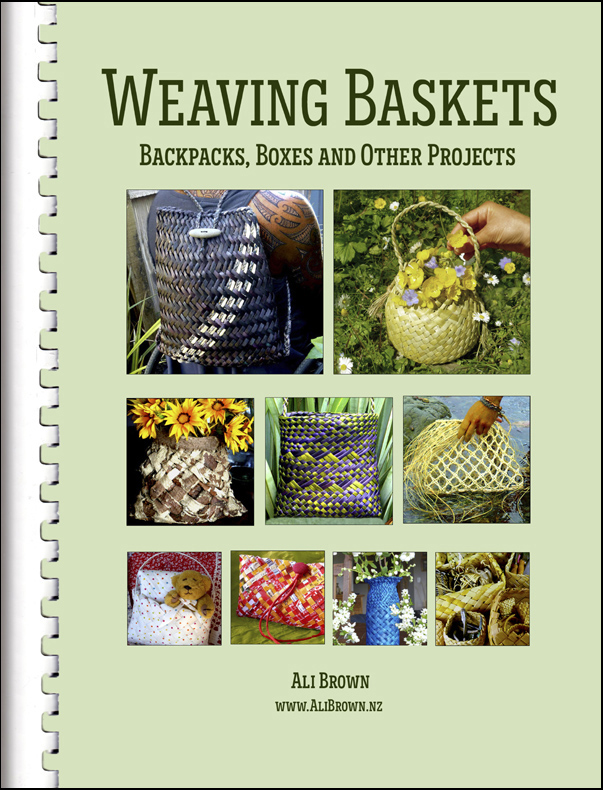
This book covers a comprehensive range of basket-making, starting from a simple woven folded-over basket (kete), to complex patterned baskets and backpacks, as well as boxes, platters, trays, vases and pots. Each project has illustrated instructions and colour photos that show step-by-step instructions for weaving using diagonal weaving and over 70 different techniques and methods used in basket-making are included. Most of the samples in the book are woven with New Zealand flax but any natural or manufactured material that can be made into long thin strips can be used, including palm leaves, strapping, bark and paper. See more information about the book here.
Weaving a Large Container from New Zealand Flax
Ali Brown. Self-published, 2012. Second Edition, 2016
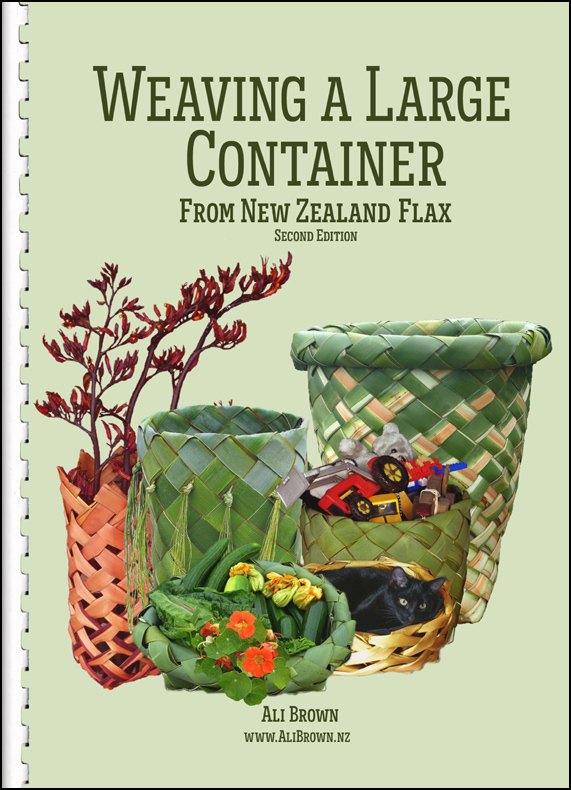
The book contains detailed instructions for weaving a large container with whole flax leaves, along with illustrated step-by-step instructions of the process. Instructions for several different ways to complete the top edge are included, and several ideas for using the basket are shown. This is a unique use of the whole of the flax leaf and this style was traditionally used for vegetable gathering baskets. Nowdays, they are becoming very popular to use as shopping baskets. Whether you are an experienced weaver or new to flax weaving, this book will provide inspiration for your weaving. See more information about the book here.
Fun and Functional Flax Weaving
Ali Brown. Self-published, 2020.
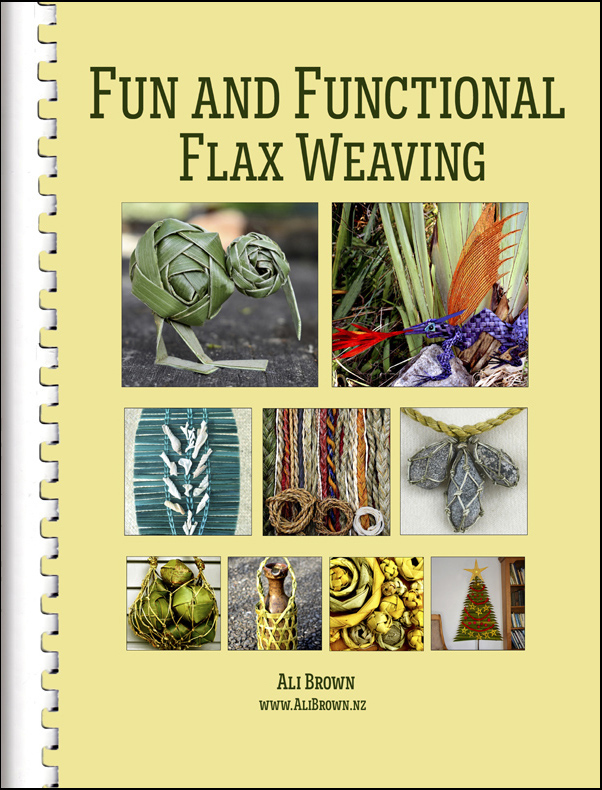
Creating useful and decorative pieces with natural materials is extremely enjoyable and satisfying. Many of the projects in this book can be achieved by those with little or no weaving experience, and there are projects that require some previous weaving knowledge for those who want to extend their weaving repertoire or who like a challenge. From delicate cords for jewellery to rugged hefty thick ropes used in outdoor art, from useful bottle carriers and decorative flask holders to toys for children and pets, window blinds and table runners, mobiles and fiery dragons, this book shows how basic weaving, knotting and plaiting techniques can be used for the creation of any number of useful, fun, and beautiful items with wide appeal. See more information about the book here.
Flax Weaving for Children of all Ages – Te Raranga Harakeke mā Ngā Tamariki Tatou
Ali Brown. Self-published, 2024.
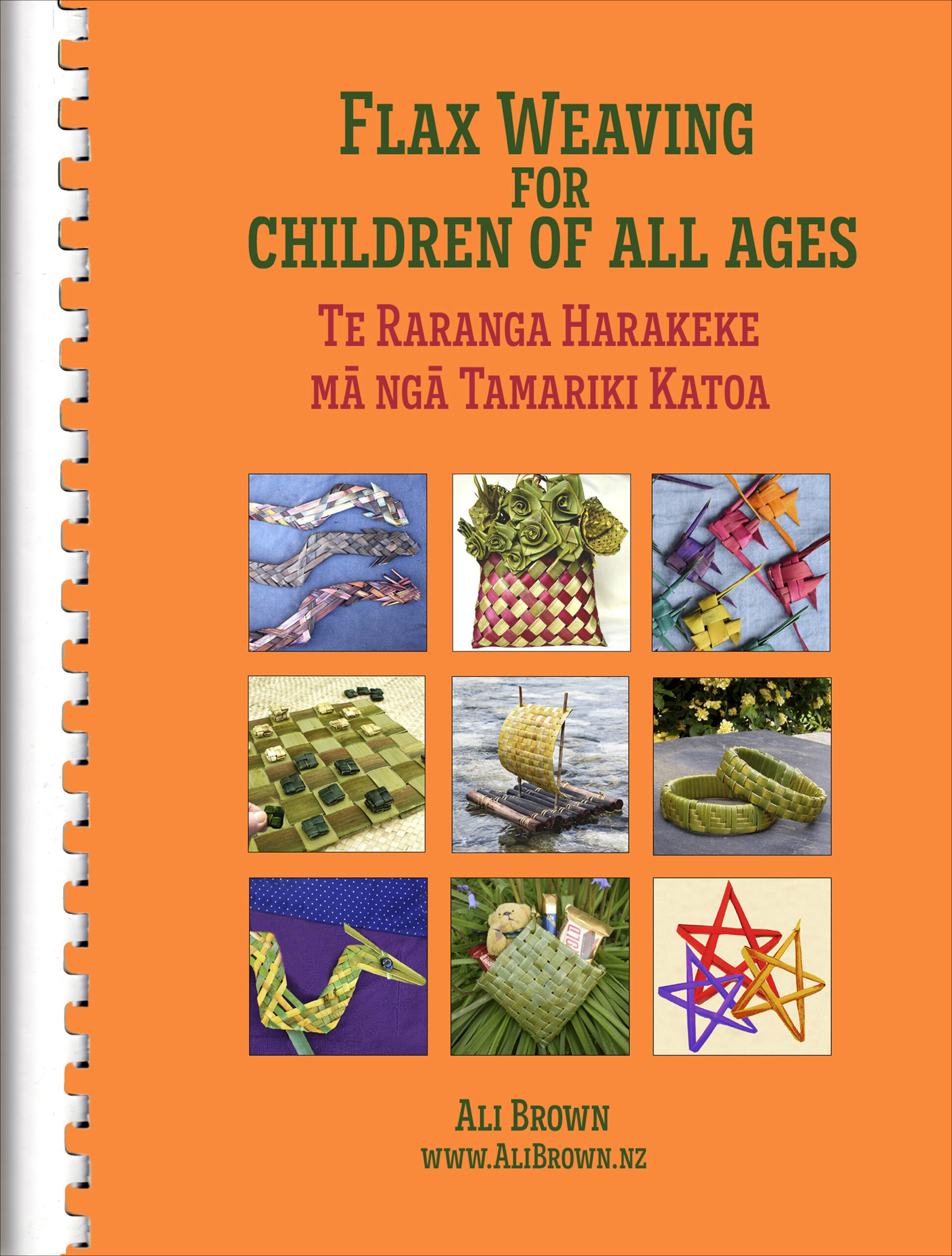
A collection of 16 weaving projects suitable for weaving at any time and especially for using in short workshops — for children and young adults, for people with different abilities, for older people and for any weaver when there’s only a little time for weaving and find their fingers are itching to weave. The book gathers together popular traditional weaving projects, contemporary projects and new designs, with something for both beginning and experienced weavers. A few of the projects are in my other books — or on my website — they are included here as they are always asked for. See more information about the book here.
Books of flaxwork exhibitions and collections
Whatu Kakahu / Māori Cloaks
Awhina Tamarapa (Editor). Te Papa Press, 2011.
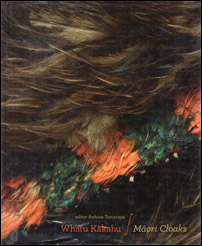
This sumptuously illustrated book opens the storeroom doors of Te Papa Museum’s cloak, or kakahu, collections to reveal the treasures within. It illuminates the magnificent cloaks in those collections and the art and tradition of whatu, or finger weft-twining, which reaches its highest expression in the form of the prestigious kakahu – the Māori cloak. Five informative chapters, each written by an expert contributor, reveal the history and significance of the weaving of cloaks. Every page is illustrated with detailed photographs and the techniques are further illustrated by fine line drawings. Forty rare kakahu are featured within this book and these are accompanied by descriptions which bring together information on every cloak – its age, materials, and weaving technique with quotes from master weavers and other experts, stories of the cloaks, and details of their provenance. A full glossary, illustrated guide to cloak types, and index are included. This book is fascinating reading both for those interested in weaving a kakahu and in the craft of weaving in general.
The Art of Māori Weaving: The Eternal Thread
Miriama Evans and Ranui Ngarimu. Huia Publishers, 2005.
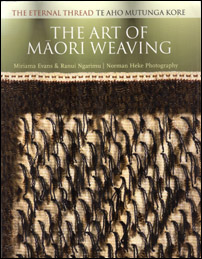
The book complements the Eternal Thread exhibition which recently toured the USA and New Zealand. It’s full of beautiful colour photos of contemporary and traditional weaving by some of New Zealand’s foremost Māori weavers. Each featured piece of weaving includes detailed descriptions of the methods used to make it, and close-up photos of selected areas provide good illustrations of particular techniques. This is an excellent reference book which celebrates the diversity and creativity of flax weaving in New Zealand.
Feathers and Fibre:
A Survey of Traditional and Contemporary Māori Craft
Mick Pendergrast. Penguin Books (NZ) Ltd, 1984.
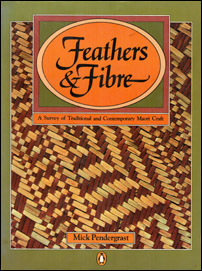
This book illustrates the Feathers and Fibre exhibition held at the Rotorua Art Gallery in New Zealand in 1984, which included a wide variety of different baskets, cloaks, belts, covered gourds, kites, mats, fish traps, fans, hats, poi and taniko weaving. The photos are mostly in black and white and include close-up views of weaving techniques of particular interest. At the back of the book there is a description of each article, the artist, and any unusual or interesting feature of the weaving. A good book to browse through for weaving ideas.
Te Aho Tapu: The Sacred Thread
Mick Pendergrast. Reed Publishing (NZ) Ltd, 1987.
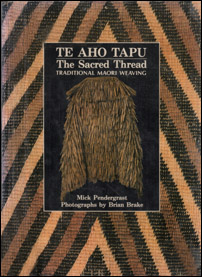
This book is based on the Te Aho Tapu exhibition of traditional Māori clothing, mainly cloaks, put on by the Auckland Institute and Museum. The exhibition was planned to coincide with the Te Māori exhibition which toured the United States in 1984, later returning to tour New Zealand. Illustrated with colour photos, there is a huge amount of information in the descriptions of the different types of cloaks and their manufacture. Cloaks are catalogued by type, name of weaver if known, measurement, materials used and other general information.
kāi tahu taoka: treasures from the Otago Museum
Reed Publishing (NZ) Ltd
in association with Otago Museum, 2006.
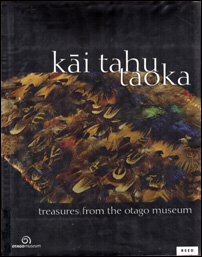
This book is full of beautiful images of some of the treaures of Kāi Tahu that are held in the Otago Museum. The pieces displayed in this book are made from a variety of materials including wood, shell, fibre, bone, stone and pounamu. The fibre section contains images of muka, flax, lacebark, and feather and wool kete, cordage, netting, an eel trap, sandals, korowai, rain cloak, feather cloak and piupiu. Full page colour images, some with close-up, detailed views of the work, provide excellent information for students of the weaving arts.
Māori Art and Culture
D C Starzecka (Editor). David Bateman Ltd, 1986.
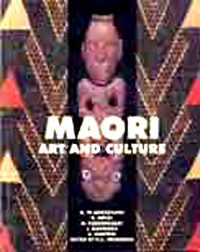
This book was written to complement an exhibition of Māori art and culture at the British Museum in 1998, and has chapters by different authors on Māori prehistory, culture, contemporary society, wood carving, the fibre arts and a description of the Māori collections in the museum. Of particular interest is Mick Pendergrast’s chapter, The Fibre Arts, which is a comprehensive essay on the history of the use of fibre in Māori culture with descriptions of the materials used for weaving, especially flax, the techniques used to weave flax and the items made with it. Particular emphasis is given to the historical development of cloak making. The book is illustrated with colour and black and white photos of items in the British Museum.
Ngā Kakahu Tuku Tho: Garments from the Past
Mary Reid. Masterprint Printers Ltd, 1987.
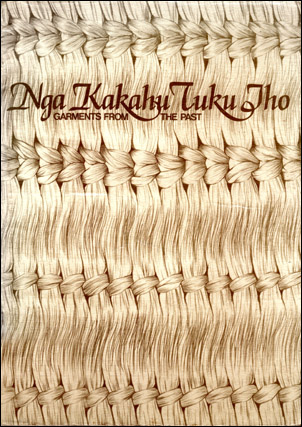
This is a programme of an exhibition held at Taranaki Museum in 1987, published in black and white. An attractive feature is the cover, which is a close-up drawing of both single and double twining, or whatu, made with delicate flax fibre, or muka, which is a feature of cloak-making. The programme lists details of the cloaks, skirts and kilts in the Taranaki Museum’s holdings that were displayed in this exhibition. Included are images and descriptions of two rare potae taua or mourning caps, both made with flax fibre and feathers.
Puawaitanga o te Ringa — Fruits of Our Busy Hands
Patricia Wallace. Christchurch City Libraries, 2003.
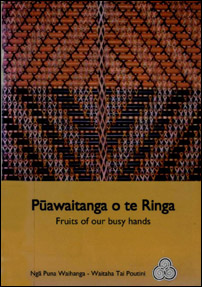
Puawaitanga o te Ringa — Fruits of Our Busy Hands is the name given to a series of decorative tukutuku panels which were especially woven as a community project for the Christchurch Central City Library’s new Ngā Pounamu Māori Centre. Illustrated in colour, the booklet includes a brief description of the community development of the Janet Stewart reserve, where the flax for the panels was harvested, and the progress and final installation of the panels.
He Kete He Korero: Every Kete Has a Story
Toi Te Rito Maihi and Maureen Lander.
Reed Publishing (NZ) Ltd, 2005.
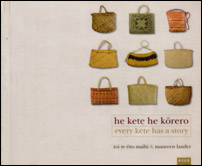
This delightful book describes the personal and historical significance of a diverse collection of twenty-one ketes. The ketes all have a connection with the north of New Zealand and range from the beautifully simple seed kumara kete, to ketes made with pīngao, lacebark and even seaweed. Large colour photos illustrate each kete and their current owner and close-up photos provide further information on the methods of weaving.
Te Ringa Rehe: The Legacy of Emily Schuster
Editor: Ane Tonga.
Rotorua Museum Te Whare Taonga o Te Arawa, 2017.
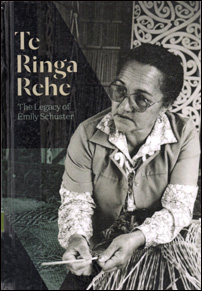
Published to support Rotorua Museum’s exhibition of Emily Schuster’s work, this publication brings together essays on her life as a weaver in the latter part of the twentieth century and the parts she played not only in the preservation of the art of weaving but also its development and resurgence. The second half of the book has coloured illustrations which show the beauty of her weaving. A fascinating glimpse of a down-to-earth master weaver’s life of weaving and her contribution to the resurgence of weaving in the late twentieth century.
Ngā Puna Roimata o te Arawa
Museum of New Zealand Te Papa Tongarewa, 1993.
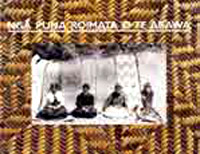
This booklet catalogues the exhibition of three Te Arawa women — Makereti Papakura, Te Hikapuhi Poihipi 2, and Rangimahora Reihana-Mete. There is a short history of each woman’s life and the illustrations show their cloaks, skirts and ketes.
E Ngā Uri Whakatupu — Weaving Legacies
Dame Rangimarie Hetet and Diggeress Te Kanawa.
Waikato Museum in association with Te Kawaunui Trust, 2015.
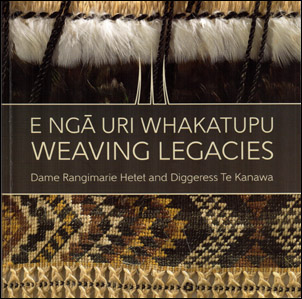
This book documents the exhibition E Ngā Uri Whakatupu, which celebrated the weaving work and legacy of two master weavers — Rangimarie Hetet and her daughter Digeress Te Kanawa. Detailed colour illustrations of beautifully presented works clearly show the fineness and quality of the work, highlighting the creativity shown by both master weavers. The exhibition contained a wide variety of both traditional and contemporary works including cloaks, woven bags of processed flax fibre, woven baskets, mats, skirts, bodices, belts and jewellery and wall hangings. The book is a valuable resource for weavers.
Rangimarie: Recollections of Her Life
Rora Paki-Titi. Huia Publishers, 1998.
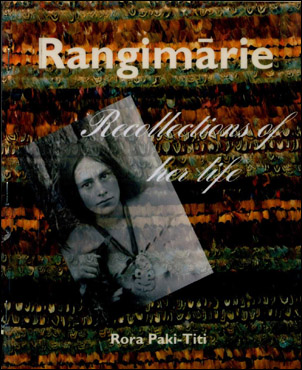
Written by her cousin and life-long friend, Rora Paki-Titi, this book contains a down-to-earth narration of the life of the renowned master weaver, Rangimarie Hetet, how weaving became an important part of her life and provides an account of King Country life from the nineteenth-century until the present day. Old black and white photos illustrate her life, and her extended family, and colour photos illustrate her weaving.
Pu Manawa: A Celebration of Whatu, Raranga and Taaniko
Megan Tamati-Quennell. Museum of NZ Te Papa Tongarewa, 1993.
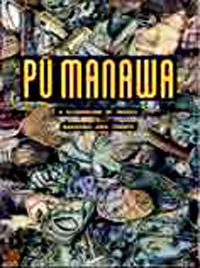
This book is published as part of Pu Manawa, an exhibition put on by the Museum of New Zealand Te Papa Tongarewa in 1993. Illustrated in colour, the book features a wide range of flax art and craft works by twenty-one Māori women including Eva Anderson, Kohai Grace, Dame Rangimarie Hetet, Kataraina Hetet-Winiata, Ruhia Oketopa, Erenora Puketapu-Hetet, Puti Rare, Emily Schuster, Tauwira (Mae) Taurua, Diggeress Te Kanawa, Christina Hurihia Wirihana, Cath Brown, Shona Rapira Davies, Nicola Ehau, Jacqueline Fraser, Maureen Lander, Toi Te Rito Maihi, Diane Prince, Lisa Reihana, Kura Te Waru Rewiri and Briar Smith, and includes their thoughts on the meaning of weaving.
Books on the role of flax within traditional Māori culture
The Coming of the Māori
Te Rangi Hiroa, Sir Peter Buck. Whitcombe and Tombs Ltd, 1949.
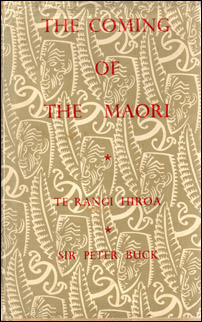
Regarded as a definitive work on Māori culture, this book has information on the discovery of New Zealand by Māori and the early settlement periods, the material culture of the Māori, the social organisation and the religion. Included in the Mats, Baskets and Plaiting section are line drawings for various weaving techniques, including how to start, join and finish a large floor mat. Included in the Clothing section are descriptions and line drawings of a number of weaving techniques, including twining and Taniko techniques and there are netting techniques in the Nets section.
Kakahu Māori Cloaks
Mick Pendergrast. David Bateman Ltd, 1997.
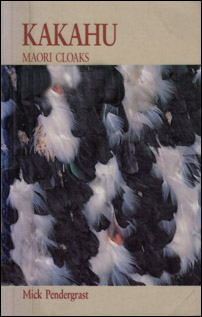
The history of cloaks and the evolution of weaving styles are discussed in depth in this informative booklet. A brief description of selected techniques used in weaving cloaks leads onto descriptions of all the major traditional styles — rain capes, kahu kuri, pukupuku, kaitaka, korowai, karure and ngore and kahu huruhuru. The booklet finishes with a discussion of the resurgence of interest in cloak-weaving in the twentieth century.
A Tohunga’s Natural World: Plants, gardening and food
Paul Moon. David Ling Publishing Limited, 2005.
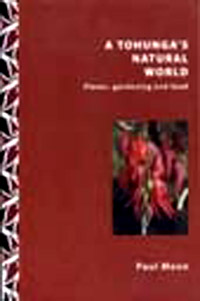
Written in a narrative style, this book follows conversations the author has with Hohepa Kereopa, a tohunga, or expert in the traditional Māori way of life. The practical information, covering gardening, food, harakeke (flax) and the medicinal uses of plants, is interspersed with Hohepa’s observations on the changing nature of traditions, the metaphysical realm and the relationships people have with their environment. The section on harakeke describes how the traditions associated with flax weaving give an understanding of family history, or whakapapa and a sense of community. This is an interesting glimpse into the everyday life of rural Māori in the mid-twentieth century.
Fishing Methods and Devices of the Māori
Elsdon Best. Te Papa Press, 2005.
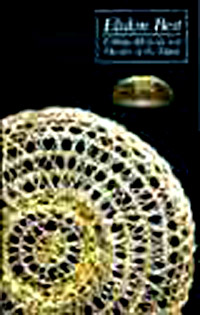
Elsdon Best (1856-1931) was an ethnologist with the Dominion Museum for 20 years and New Zealand’s foremost writer on pre-European Māori life. Of interest in this book is a section on the way flax was used to make fishing nets and traps, the larger nets being made with flax strips and the smaller nets and traps with flax cord. Included is a fascinating description on the manufacture and use of deep-sea fishing nets, some of which were up to 1,000 yards long, and required several hundred men and double canoes to take them out to the fishing beds and haul the huge catch of fish in.
Forest Lore of the Māori
Elsdon Best. Te Papa Press, 2005.
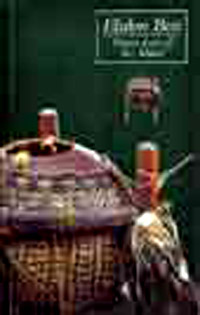
Although there is very little information on flax weaving in this book, the image of a preserved-bird container on the cover is stunning. The container is a gourd that has been cut off at the stem and covered with woven dyed flax. The vessel has three or four wooden legs attached to two wooden hoops and is adorned with feathers. Traditionally, these decorated containers were used on festive occasions.
Māori: The Origin, Art and Culture of the Māori People of New Zealand
Barry Mitcalfe. Coromandel Press, 1981.
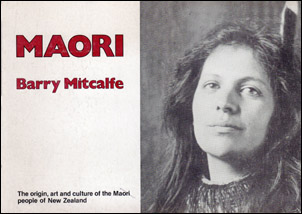
Reconstructing Māori life on the basis of archaeological evidence, this book give thoughts on how the first Polynesians who came to New Zealand adapted to the colder climate and the forest resources. Inluded are a number of maps of archeology sites and soil cross-sections, which have been used to illustrate the archelogical evidence. There are a number of historical black and white photos with many photos of woven cloaks, skirts and baskets. Also included are several photos of korowai cloaks and a wonderful photo of a large kete being used for kumara gathering.
New Zealand Medicinal Plants
S G Brooker, R C Cambie, R C Cooper. Heinemann Publishers, 1987.
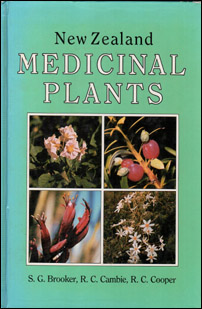
Along with information on many other plants, this book details the traditional use of flax for a wide variety of medicinal purposes, including poultices, ointments, and internal use. All parts of the flax leaf have been useful for medicinal purposes and continue today in traditional medicinal use. For example, the processed root of the leaf can be used as a hot compress for infection and swelling and the gum inside the leaf can be applied to burns and wounds as well as skin infections. The book also includes some notes on the biochemistry of flax extracts.
Greenstone Trails: The Māori Search for Pounamu
Barry Brailsford. Reed Publishing (NZ) Ltd, 1984.
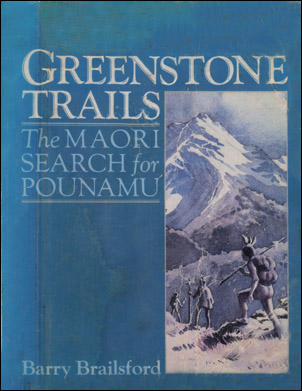
Barry Brailsford describes in detail both the Māori and European expeditions in search of greenstone, or pounamu, in the South Island of New Zealand. Items made with flax played a major part in these expeditions, one of the more dramatic examples being the use of flax ropes to scale cliffs. Flax was also used for sandals, basketry and clothing and flower stalks lashed together were used to make rafts for crossing rivers.
Magazines of contemporary weaving groups
Te Roopu Raranga Whatu o Aotearoa
Magazine of Toi Māori Aotearoa, published 2-3 times per year.
Available from Toi Māori Aotearoa.
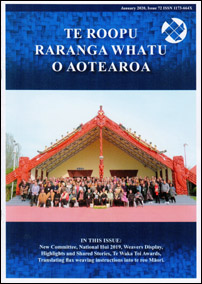
This magazine, produced by Toi Māori Aotearoa, a national organisation promoting Māori art, is produced specifically for Te Roopu Raranga Whatu o Aotearoa, the national organisation for flax weavers. It includes articles on a diverse range of topics associeted with weaving and other traditional creative arts and inludes weaver profiles, articles about plants used for weaving, discussion on Māori art, reviews of exhibitions and gatherings, and weaving tips and ideas and gives information on coming events. Contact the group here for membership.
Creative Fibre
Journal of the New Zealand Spinning, Weaving
and Woolcrafts Society Inc. Published quarterly.
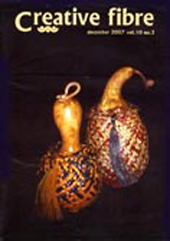
Creative Fibre is a national organisation for all fibre crafts and it includes spinners, weavers, knitters, dyers, flax workers, felters, crocheters, free-form fibre artists and all other people involved in the use of fibre. Regional and national exhibitions are held on a regular basis and examples of flax weaving are often entered in these exhibitions. Although most of the images in the magazine are from other fibre crafts, every now and then, flax works will be illustrated in the magazine. Contact the group here for membership.
Books on growing and harvesting flax
Insect Pests and Diseases of Harakeke
Sue Scheele. Manaaki Whenua Press, 1998.
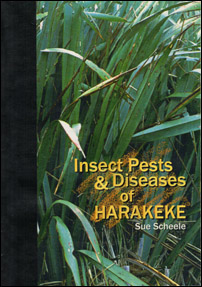
For those growing and looking after their own flax bushes, this book has essential information on keeping bushes free of pests and diseases. There are good descriptions and diagrams of the main insects that attack the flax plant and how to prevent and control these pests. These include natural control measures, insecticide sprays and home remedies.
Harakeke: The Rene Orchiston Collection
Sue Scheel and Geoff Walls. Manaaki Whenua Press, 2005.
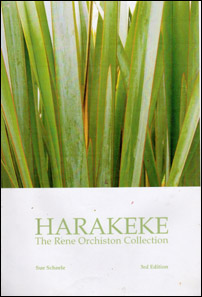
This booklet describes the leaves, flowers and the most suitable weaving uses for sixty-three different flax varieties, some of which are illustrated with colour photographs. This collection was gathered and catalogued by Rene Orchiston over many years and from many parts of New Zealand, and is now cared for by Manaaki Whenua Landcare Research at Lincoln, Christchurch. Landcare Research has carried out DNA fingerprinting of all the varieties, and although most of the plants in the Orchiston Collection are unique varieties, several groups with identical genetic makeup have been identified, which means that these plants are either originally from the same geographical area or wild population or are divisions of the same parent plant.
Pīngao: The Golden Sand Sedge
Ngā Puna Waihanga, 1991.
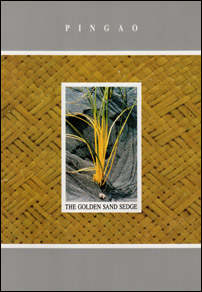
Pīngao, a golden sand sedge, is a favoured weaving plant because of the rich yellow colour it dries to. Pīngao’s growth declined in the first half of the twentieth century, and this booklet was written to promote the reintroduction of it both in public and private plantings. The booklet contains practical information on how to propagate and grow pīngao from seed and cuttings and a description of the plant’s use for erosion control and dune rehabilitation. There are good coloured images throughout the book, including an interesting image of the extensive use of pīngao in a tukutuku panel.
Flax — The Enduring Fibre
Feature article in New Zealand Geographic, Number 42, April–June 1999.
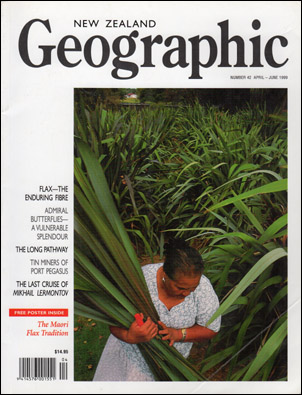
A very readable article that focuses on the way the flax plant has been used in New Zealand. It describes the different types of flax plants, and the origin of the Rene Orchiston collection at Manaaki Whenua Landcare Research, and goes on to discuss the importance of flax in early Māori culture. A section on the conservation work being carried out to preserve old flax artefacts includes the degradational effects of traditional dye methods on the flax fibre. The article also describes the role that the flax-milling industry played in New Zealand history, the breeding of coloured, ornamental cultivars, and the part flax plays in modern technology, medicine and fashion. Another section describes the insect life on flax plants. The Linen Years describes the growing of European flax, Linum usitatissimum, in New Zealand as a contribution to the manufacture of Britain’s war equipment during World War Two. Good colour and black and white photos complement the article.
© Ali Brown 2006. Last updated 2021
